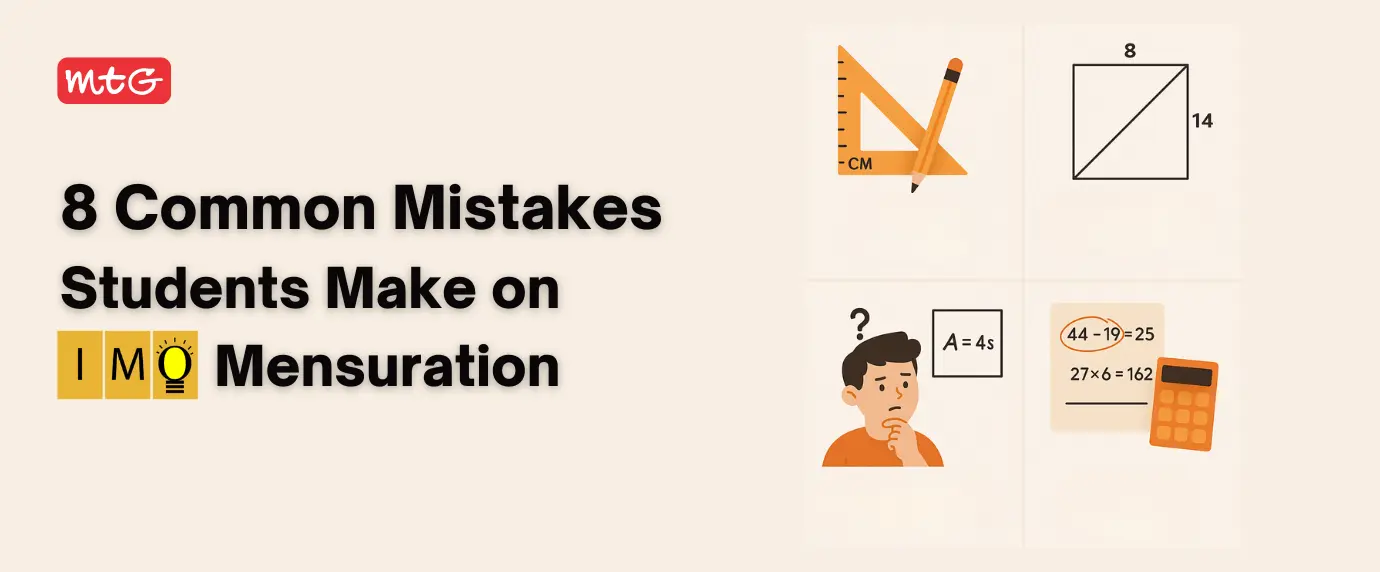
For students preparing for the International Mathematics Olympiad (IMO) of the Science Olympiad Foundation, mensuration is usually introduced in class 6 and continues to be built upon in higher grades, such as class 8 and 10. While all formulas are important for mensuration, relying on them alone would not be enough for the Olympiad-level questions for Mathematics. You need concept clarity, presence of mind, and the ability to see beyond what is obvious. Even the bright students make the same kinds of mistakes again and again, not because they don’t study well, but because they miss small but crucial details in their thinking or problem-solving approach. In this blog, we will look at 8 realistic and overlooked mistakes students make while solving mensuration questions in the IMO, and how they can avoid them with smart strategies and practice.
1. Treating a Composite Figure as a Single Shape
In Olympiad papers, figures are rarely just a cone or a cylinder. And most of the time, they are a combination like a cylinder with a hemisphere on top or a cube carved out of a larger cuboid. But many students still try to apply formulas as if the figure is just one shape. This usually leads to the wrong answer.
What to do instead:
- Mentally break the figure into smaller, known shapes.
- Calculate surface area or volume for each, then combine them logically.
- Do not forget that if some faces are hidden or joined, you may not need to count them in the surface area.
Real scenario: A student calculated the total surface area of a cone + cylinder by adding both full areas, forgetting that the base of the cone and the top of the cylinder are merged, not separate.
2. Ignoring the Hidden Hollow in 3D Shapes
This is especially common in pipe or cylindrical shell questions. Many students calculate the volume as if it’s solid, ignoring that the shape is hollow inside.
Why it matters:
The presence of an inner radius changes both volume and surface area.
How to fix it:
- For hollow shapes, use:
Volume = πh(R² – r²) where R = outer radius, r = inner radius. - Pay attention to whether the inner surface is also part of what’s being asked.
Olympiad twist: A tank-shaped question asked for the cost of painting the inside. The student painted the outer surface instead.
3. Getting Tricked by Unlabelled Diagrams
Olympiad questions often provide minimalist diagrams with missing labels, misleading scales, or unmarked dimensions. This leads students to either assume incorrect measurements or skip interpreting parts of the figure.
How to avoid this:
- Don’t assume anything not stated.
- Read the full description even if the figure seems clear.
- Use logic to deduce missing dimensions (sometimes one part of the question indirectly gives it away).
- Practice drawing your own labelled version of the diagram as part of your rough work.
Read: How to attempt all sections of the IMO paper
4. Confusing Slant Height with Vertical Height
In cones and pyramids, students often mix up height and slant height, especially when only one is mentioned. This one detail can ruin the entire calculation for surface area or volume.
Quick reminder:
- Slant height is used for surface area (like painting the cone’s sides).
- Vertical height is used for volume (filling the cone).
Fix:
- Use the Pythagoras Theorem when needed
- l² = r² + h² (where l is slant height, r is base radius, h is vertical height).
Refresh key formulas: Key formulas & concepts for IMO
5. Forgetting Real-World Contexts (Like Thickness or Wastage)
Some mensuration problems aren’t pure math, they’re word problems involving real-life situations like fencing, painting, filling, or wrapping.
Students often miss the practical adjustments needed for such problems.
Example: A question asked for the volume of water a tank can hold. The tank had 2 cm-thick walls, but the student calculated using outer dimensions.
Fix:
- Adjust dimensions to account for material thickness, gaps, or layers.
- Read questions carefully for phrases like inner surface, usable area, excluding top, etc.
Use structured theory + practice from Olympiad Prep‑Guide (IMO)
6. Misinterpreting “Open” vs “Closed” Containers
Students frequently calculate surface area for a closed figure when the question clearly says it’s open from one side.
What this leads to: Over-counting one face (like the top of a box or the bottom of a cylinder).
How to handle it:
- Visualise the object like it exists in real life.
- Ask yourself: would this surface need painting or covering?
- Open box? Skip the top. Open cylinder? Skip the base.
Build speed + accuracy with IMO online mock tests
7. Applying 2D Logic to 3D Problems and vice versa
This is a subtle but damaging mistake. Students apply area-based logic to volume-based questions or forget that scaling works differently in 3D. If the dimensions double, the area becomes 4 times, and the volume becomes 8 times.
Fix: When scale changes, think in terms of powers:
- Length → multiply by k
- Area → multiply by k²
- Volume → multiply by k³
This helps especially in Olympiad “compare” questions that ask you to find ratios or percentage changes.
8. Leaving Answers in the Wrong Units
Sounds simple, but it is a very real issue. You do all the math correctly and then lose marks because your answer was in cm² instead of m².
What happens:
- Units get mixed when lengths are in cm, but costs are per m².
- Students forget to convert before the final calculation.
How to avoid:
- Convert units before plugging into formulas.
- Always check what unit the final answer needs to be in.
Last‑minute checks: Class 8 Mathematics MCQs (chapterwise) and MTG Free Resources hub.
Smart Tip: Create a Mensuration Checklist
Before solving any mensuration question, ask yourself:
- Is the shape composite or hollow?
- Are units consistent?
- Are the right dimensions given or implied?
- Is it asking for curved, total, or lateral surface area?
- Should I be using radius, diameter, height, or slant height?
Keeping this mental checklist will save you from 90% of common errors in your SOF IMO exam.
Conclusion
Mensuration in IMO is not only about formulas, it is about thinking, avoiding assumptions, and spotting the hidden challenges within a question. The mistakes we have covered here are not random, they are patterns seen in hundreds of students, and once you are aware of them, they are easy to fix. Start building these habits like slow down and read carefully, visualise every figure, practice variety, not just volume.
If you want structured, step-by-step support in mastering these skills, explore MTG(the Only academic partner of the SOF Olympiad) resources, which focus on concept clarity and Olympiad-level challenges for IMO and other Olympiads as well, so start today with the structured learning.
Also consider digital practice via: IMO Online Test Package (Class 6) or IMO Online Test Package (Class 10).






























